Hyundai H350 2015 Owner's Guide
Manufacturer: HYUNDAI, Model Year: 2015, Model line: H350, Model: Hyundai H350 2015Pages: 473, PDF Size: 26.4 MB
Page 21 of 473
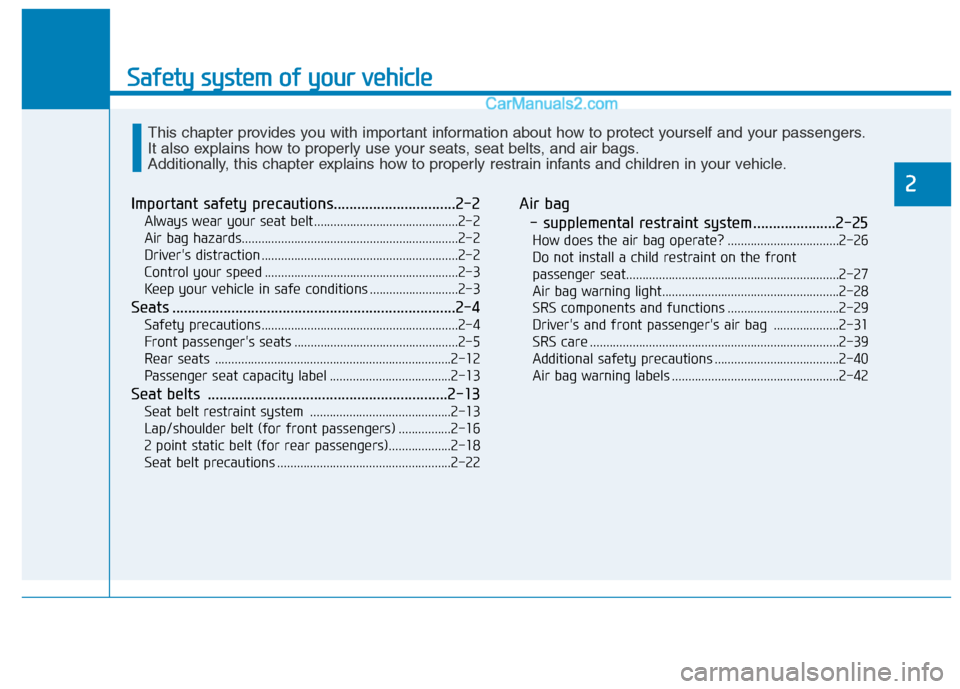
Safety system of your vehicle
2
Important safety precautions...............................2-2Always wear your seat belt............................................2-2
Air bag hazards..................................................................2-2
Driver's distraction ............................................................2-2
Control your speed ...........................................................2-3
Keep your vehicle in safe conditions ...........................2-3
Seats ........................................................................2-4 Safety precautions............................................................2-4
Front passenger's seats ..................................................2-5
Rear seats ........................................................................2-12
Passenger seat capacity label .....................................2-13
Seat belts .............................................................2-13 Seat belt restraint system ...........................................2-13
Lap/shoulder belt (for front passengers) ................2-16
2 point static belt (for rear passengers)...................2-18
Seat belt precautions .....................................................2-22 Air bag
- supplemental restraint system.....................2-25How does the air bag operate? ..................................2-26
Do not install a child restraint on the front
passenger seat.................................................................2-27 Air bag warning light......................................................2-28
SRS components and functions ..................................2-29
Driver's and front passenger's air bag ....................2-31
SRS care ............................................................................2-39
Additional safety precautions ......................................2-40
Air bag warning labels ...................................................2-42
This chapter provides you with important information about how to protect yourself and your passengers.
It also explains how to properly use your seats, seat belts, and air bags.
Additionally, this chapter explains how to properly restrain infants and children in your vehicle.
Page 22 of 473
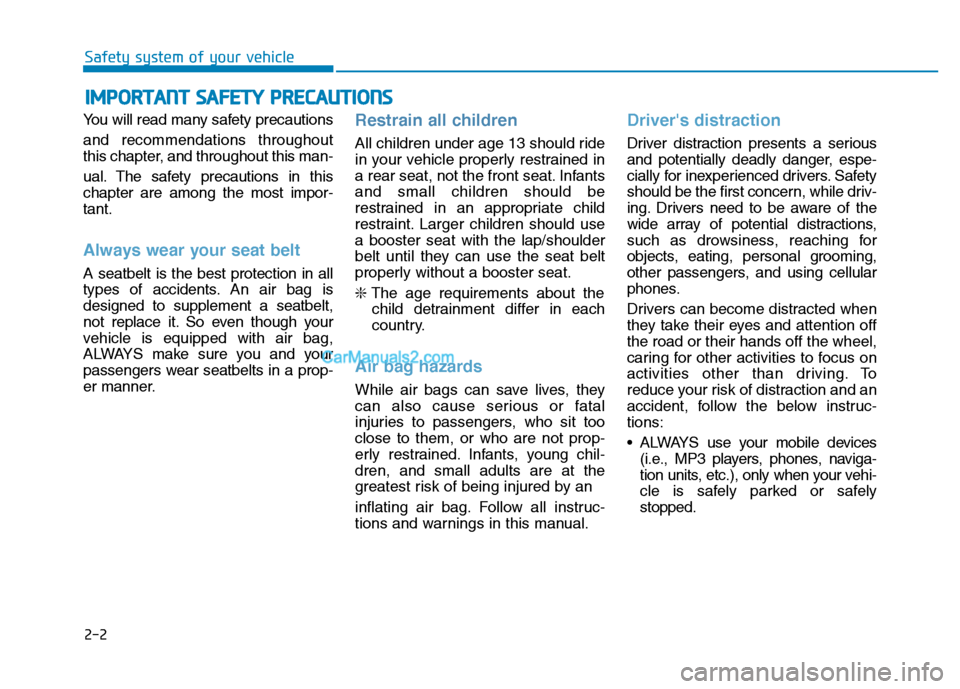
2-2
You will read many safety precautions and recommendations throughout
this chapter, and throughout this man-
ual. The safety precautions in this chapter are among the most impor-tant.
Always wear your seat belt
A seatbelt is the best protection in all
types of accidents. An air bag isdesigned to supplement a seatbelt,
not replace it. So even though your
vehicle is equipped with air bag,
ALWAYS make sure you and your
passengers wear seatbelts in a prop-
er manner.
Restrain all children
All children under age 13 should ride
in your vehicle properly restrained in
a rear seat, not the front seat. Infantsand small children should be
restrained in an appropriate child
restraint. Larger children should usea booster seat with the lap/shoulder
belt until they can use the seat belt
properly without a booster seat. ❇
The age requirements about the
child detrainment differ in each
country.
Air bag hazards
While air bags can save lives, they
can also cause serious or fatal
injuries to passengers, who sit tooclose to them, or who are not prop-
erly restrained. Infants, young chil-dren, and small adults are at the
greatest risk of being injured by an
inflating air bag. Follow all instruc-
tions and warnings in this manual.
Driver's distraction
Driver distraction presents a serious
and potentially deadly danger, espe-
cially for inexperienced drivers. Safety
should be the first concern, while driv-
ing. Drivers need to be aware of the
wide array of potential distractions,
such as drowsiness, reaching for
objects, eating, personal grooming,
other passengers, and using cellular
phones.
Drivers can become distracted when
they take their eyes and attention offthe road or their hands off the wheel,
caring for other activities to focus on
activities other than driving. To
reduce your risk of distraction and an
accident, follow the below instruc-tions:
• ALWAYS use your mobile devices (i.e., MP3 players, phones, naviga-
tion units, etc.), only when your vehi-
cle is safely parked or safelystopped.
IIMM PPOO RRTTAA NN TT SS AA FFEE TT YY PP RR EECCAA UU TTIIOO NNSS
Safety system of your vehicle
Page 23 of 473
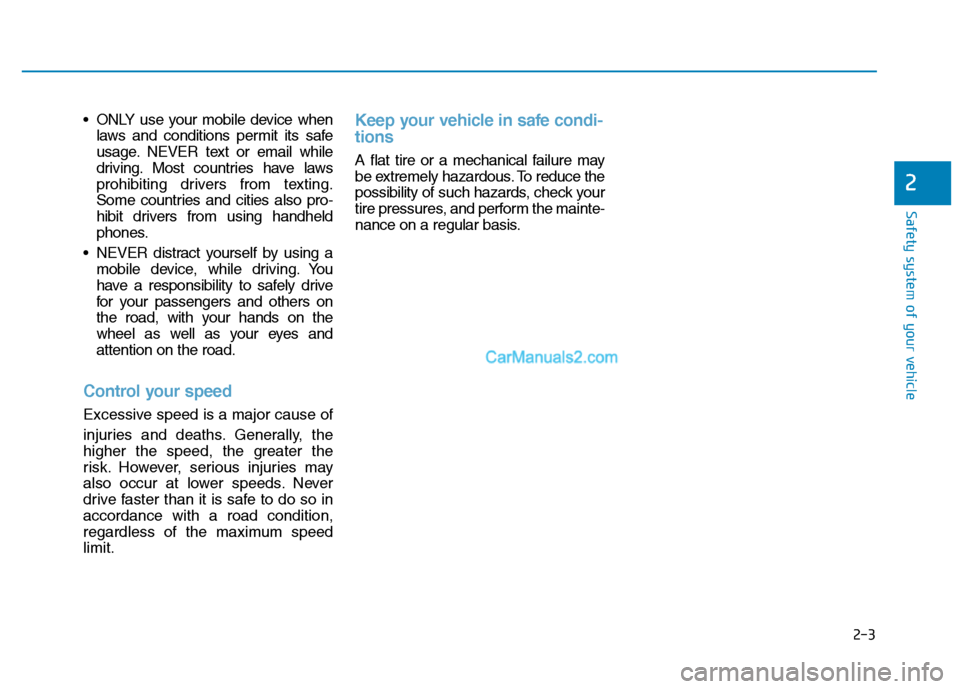
2-3
Safety system of your vehicle
ONLY use your mobile device whenlaws and conditions permit its safe
usage. NEVER text or email while
driving. Most countries have laws
prohibiting drivers from texting.
Some countries and cities also pro-
hibit drivers from using handheld
phones.
NEVER distract yourself by using a mobile device, while driving. You
have a responsibility to safely drive
for your passengers and others on
the road, with your hands on the
wheel as well as your eyes andattention on the road.
Control your speed
Excessive speed is a major cause of
injuries and deaths. Generally, the
higher the speed, the greater the
risk. However, serious injuries may
also occur at lower speeds. Never
drive faster than it is safe to do so inaccordance with a road condition,
regardless of the maximum speedlimit.
Keep your vehicle in safe condi- tions
A flat tire or a mechanical failure may
be extremely hazardous. To reduce the
possibility of such hazards, check your
tire pressures, and perform the mainte-
nance on a regular basis.
2
Page 24 of 473
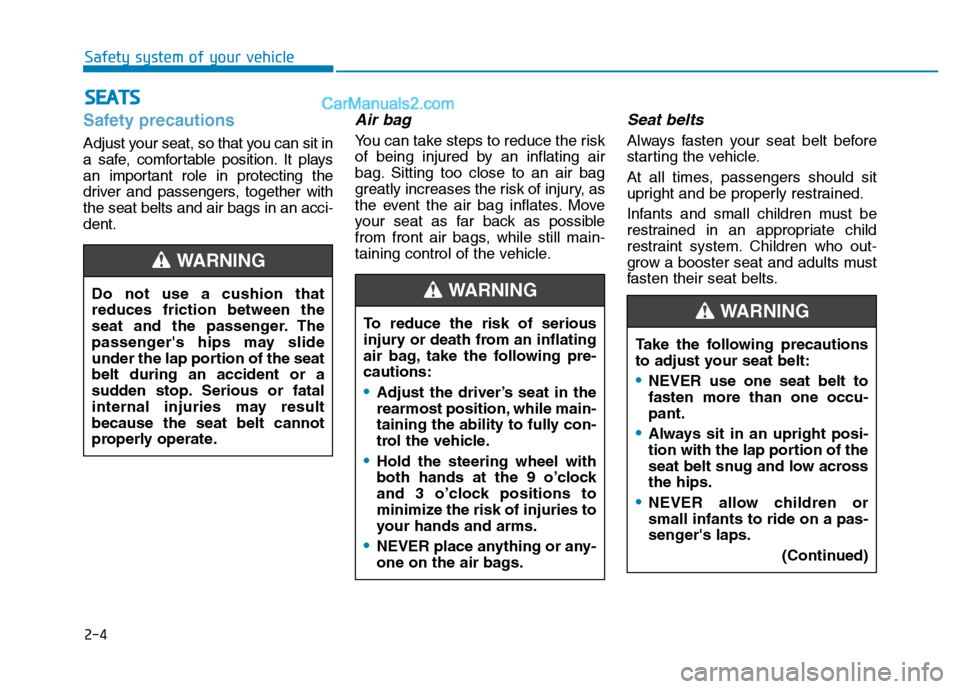
2-4
Safety system of your vehicleS
S EE AA TTSS
Safety precautions
Adjust your seat, so that you can sit in
a safe, comfortable position. It plays
an important role in protecting the
driver and passengers, together withthe seat belts and air bags in an acci-dent.
Air bag
You can take steps to reduce the risk
of being injured by an inflating air
bag. Sitting too close to an air bag
greatly increases the risk of injury, as
the event the air bag inflates. Move
your seat as far back as possible
from front air bags, while still main-
taining control of the vehicle.
Seat belts
Always fasten your seat belt before
starting the vehicle.
At all times, passengers should sit
upright and be properly restrained.
Infants and small children must be
restrained in an appropriate child
restraint system. Children who out-
grow a booster seat and adults must
fasten their seat belts.
Do not use a cushion thatreduces friction between the
seat and the passenger. The
passenger's hips may slide
under the lap portion of the seatbelt during an accident or a
sudden stop. Serious or fatal
internal injuries may resultbecause the seat belt cannot
properly operate.
WARNING
To reduce the risk of serious
injury or death from an inflating
air bag, take the following pre-cautions:
•Adjust the driver’s seat in the
rearmost position, while main-
taining the ability to fully con-
trol the vehicle.
Hold the steering wheel with
both hands at the 9 o’clock
and 3 o’clock positions to
minimize the risk of injuries to
your hands and arms.
NEVER place anything or any-
one on the air bags.
WARNING
Take the following precautions
to adjust your seat belt:
NEVER use one seat belt to fasten more than one occu-pant.
Always sit in an upright posi-
tion with the lap portion of the
seat belt snug and low acrossthe hips.
NEVER allow children or small infants to ride on a pas-
senger's laps.
(Continued)
WARNING
Page 25 of 473
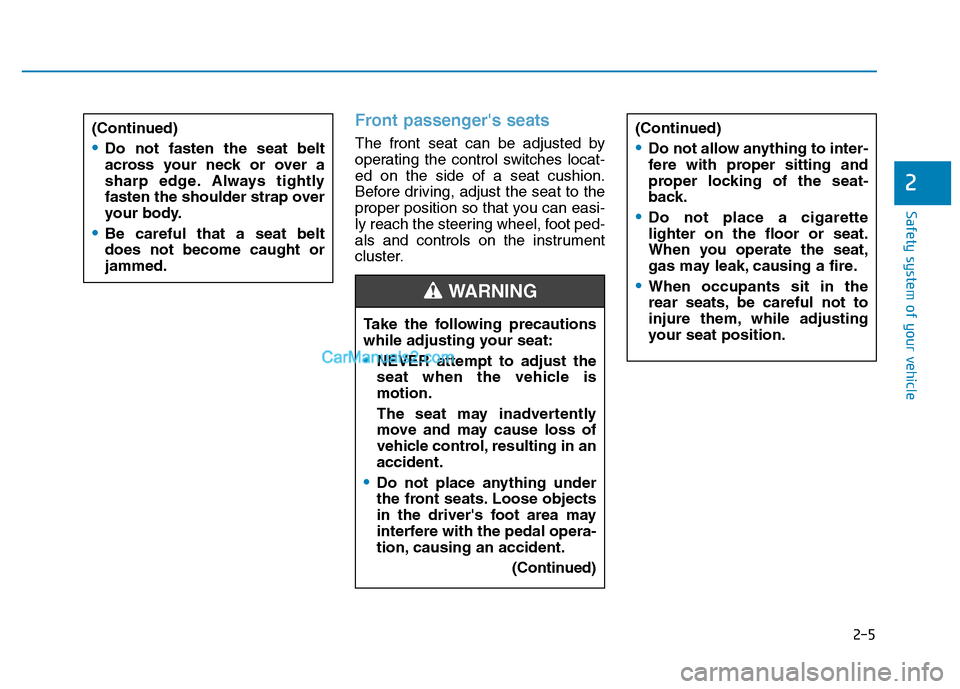
2-5
Safety system of your vehicle
2
Front passenger's seats
The front seat can be adjusted by
operating the control switches locat-ed on the side of a seat cushion.
Before driving, adjust the seat to the
proper position so that you can easi-
ly reach the steering wheel, foot ped-
als and controls on the instrument
cluster.Take the following precautions
while adjusting your seat:
NEVER attempt to adjust the
seat when the vehicle ismotion.
The seat may inadvertently
move and may cause loss of
vehicle control, resulting in anaccident.
Do not place anything under
the front seats. Loose objects
in the driver's foot area may
interfere with the pedal opera-
tion, causing an accident. (Continued)
WARNING
(Continued)
Do not fasten the seat belt
across your neck or over a
sharp edge. Always tightly
fasten the shoulder strap over
your body.
Be careful that a seat belt does not become caught orjammed.
(Continued)
Do not allow anything to inter-
fere with proper sitting and
proper locking of the seat-
back.
Do not place a cigarette lighter on the floor or seat.
When you operate the seat,
gas may leak, causing a fire.
When occupants sit in the
rear seats, be careful not to
injure them, while adjusting
your seat position.
Page 26 of 473
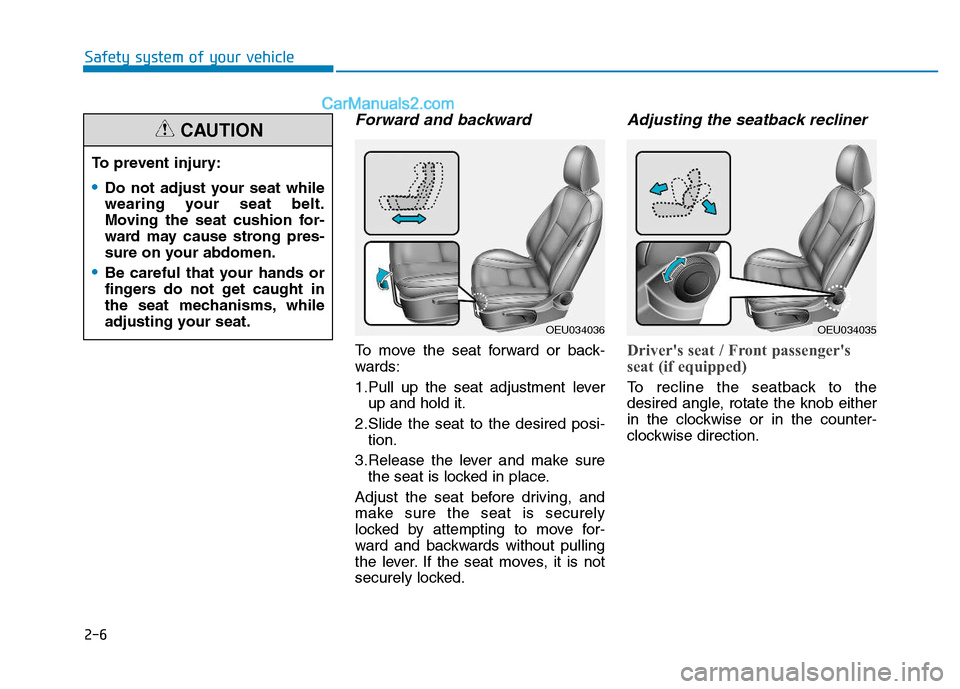
2-6
Safety system of your vehicle
Forward and backward
To move the seat forward or back-
wards:
1.Pull up the seat adjustment leverup and hold it.
2.Slide the seat to the desired posi- tion.
3.Release the lever and make sure the seat is locked in place.
Adjust the seat before driving, and
make sure the seat is securely
locked by attempting to move for-
ward and backwards without pulling
the lever. If the seat moves, it is not
securely locked.
Adjusting the seatback recliner
Driver's seat / Front passenger's
seat (if equipped)
To recline the seatback to the
desired angle, rotate the knob either
in the clockwise or in the counter-
clockwise direction.
To prevent injury:
Do not adjust your seat while
wearing your seat belt.
Moving the seat cushion for-
ward may cause strong pres-
sure on your abdomen.
Be careful that your hands or
fingers do not get caught in
the seat mechanisms, while
adjusting your seat.
CAUTION
OEU034036OEU034035
Page 27 of 473
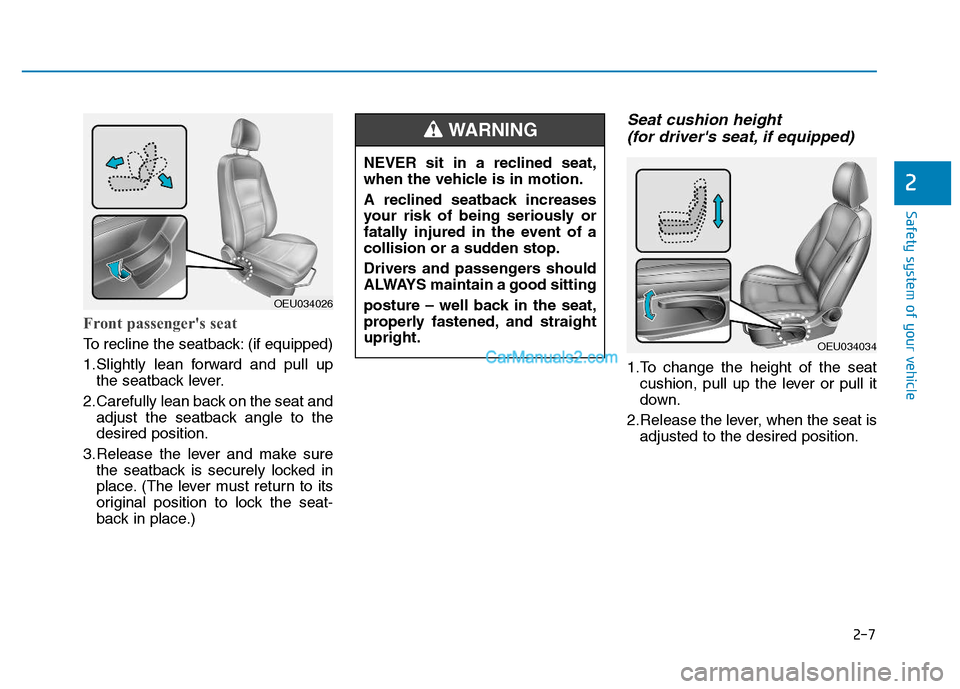
2-7
Safety system of your vehicle
2
Front passenger's seat
To recline the seatback: (if equipped)
1.Slightly lean forward and pull upthe seatback lever.
2.Carefully lean back on the seat and adjust the seatback angle to the desired position.
3.Release the lever and make sure the seatback is securely locked in
place. (The lever must return to its
original position to lock the seat-
back in place.)
Seat cushion height
(for driver's seat, if equipped)
1.To change the height of the seat cushion, pull up the lever or pull it
down.
2.Release the lever, when the seat is adjusted to the desired position.
OEU034026 NEVER sit in a reclined seat,
when the vehicle is in motion.
A reclined seatback increases
your risk of being seriously or
fatally injured in the event of a
collision or a sudden stop.
Drivers and passengers should
ALWAYS maintain a good sitting
posture – well back in the seat,
properly fastened, and straightupright.
WARNING
OEU034034
Page 28 of 473
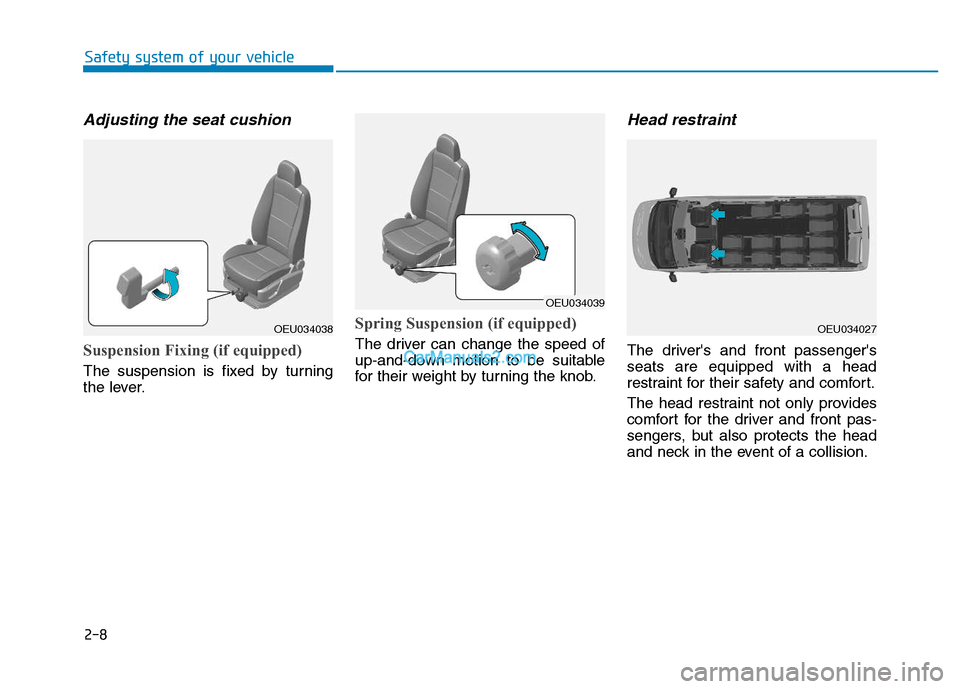
2-8
Adjusting the seat cushion
Suspension Fixing (if equipped)
The suspension is fixed by turning
the lever.
Spring Suspension (if equipped)
The driver can change the speed of
up-and-down motion to be suitable
for their weight by turning the knob.
Head restraint
The driver's and front passenger'sseats are equipped with a head
restraint for their safety and comfort.
The head restraint not only provides
comfort for the driver and front pas-
sengers, but also protects the head
and neck in the event of a collision.
Safety system of your vehicle
OEU034038
OEU034039
OEU034027
Page 29 of 473
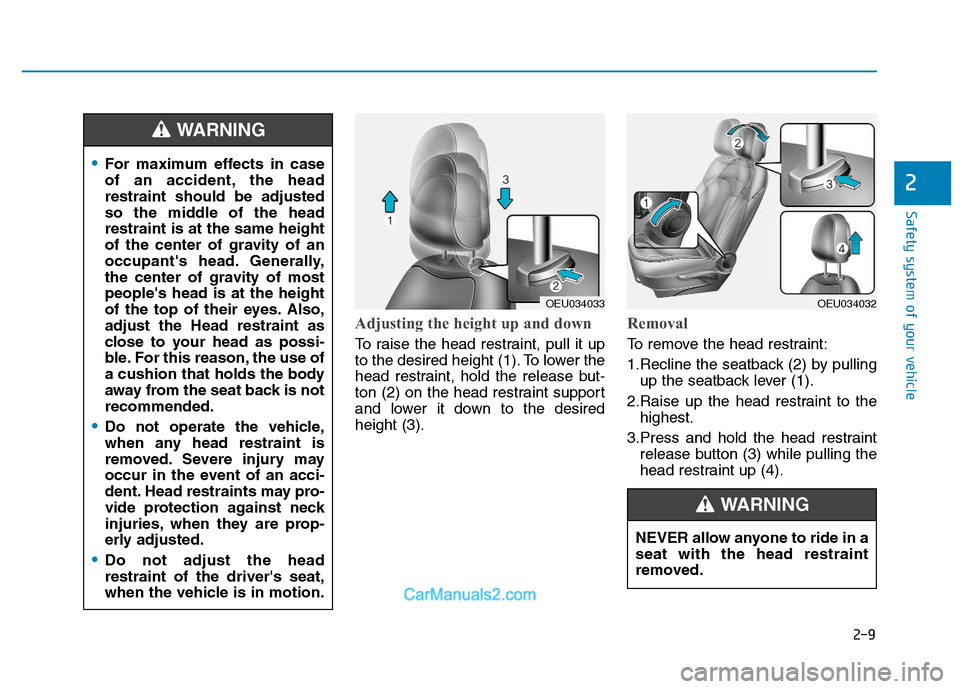
2-9
Safety system of your vehicle
2
Adjusting the height up and down
To raise the head restraint, pull it up
to the desired height (1). To lower the
head restraint, hold the release but-
ton (2) on the head restraint support
and lower it down to the desiredheight (3).
Removal
To remove the head restraint:
1.Recline the seatback (2) by pullingup the seatback lever (1).
2.Raise up the head restraint to the highest.
3.Press and hold the head restraint release button (3) while pulling the
head restraint up (4).
For maximum effects in case
of an accident, the headrestraint should be adjusted
so the middle of the headrestraint is at the same height
of the center of gravity of an
occupant's head. Generally,
the center of gravity of mostpeople's head is at the height
of the top of their eyes. Also,adjust the Head restraint as
close to your head as possi-
ble. For this reason, the use of
a cushion that holds the body
away from the seat back is notrecommended.
Do not operate the vehicle,
when any head restraint is
removed. Severe injury may
occur in the event of an acci-
dent. Head restraints may pro-
vide protection against neck
injuries, when they are prop-
erly adjusted.
Do not adjust the head restraint of the driver's seat,
when the vehicle is in motion.
WARNING
OEU034033OEU034032
NEVER allow anyone to ride in a seat with the head restraint
removed.
WARNING
Page 30 of 473
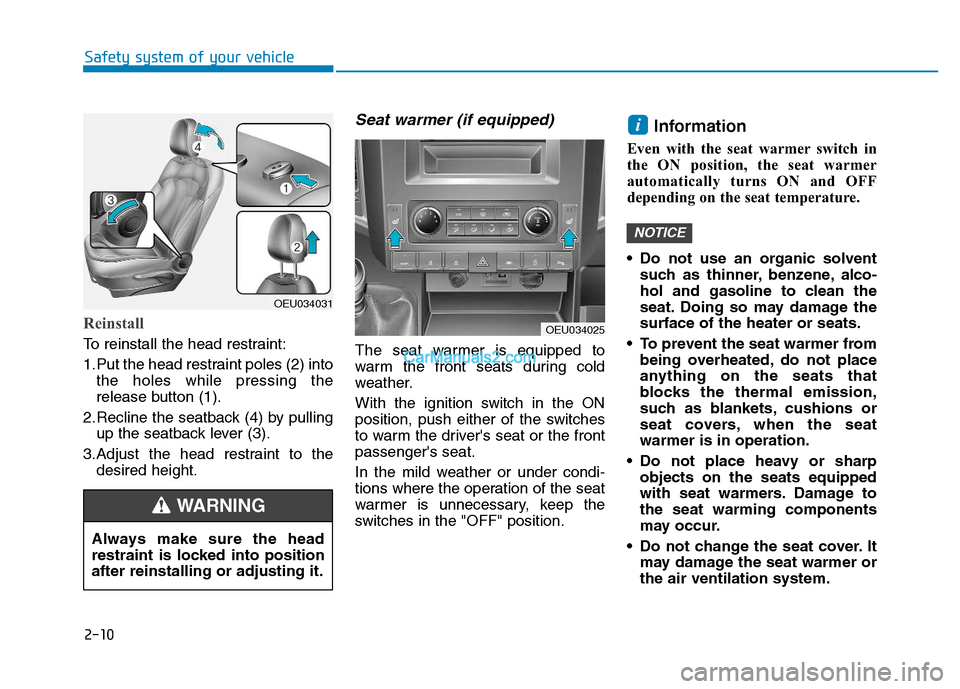
2-10
Safety system of your vehicle
Reinstall
To reinstall the head restraint:
1.Put the head restraint poles (2) intothe holes while pressing the
release button (1).
2.Recline the seatback (4) by pulling up the seatback lever (3).
3.Adjust the head restraint to the desired height.
Seat warmer (if equipped)
The seat warmer is equipped to
warm the front seats during cold
weather.
With the ignition switch in the ON
position, push either of the switches
to warm the driver's seat or the frontpassenger's seat.
In the mild weather or under condi-
tions where the operation of the seat
warmer is unnecessary, keep the
switches in the "OFF" position. Information
Even with the seat warmer switch in
the ON position, the seat warmer
automatically turns ON and OFF
depending on the seat temperature.
Do not use an organic solvent such as thinner, benzene, alco-
hol and gasoline to clean the
seat. Doing so may damage thesurface of the heater or seats.
To prevent the seat warmer from being overheated, do not place
anything on the seats that
blocks the thermal emission,
such as blankets, cushions or
seat covers, when the seatwarmer is in operation.
Do not place heavy or sharp objects on the seats equipped
with seat warmers. Damage tothe seat warming components
may occur.
Do not change the seat cover. It may damage the seat warmer orthe air ventilation system.
NOTICE
i
OEU034031
Always make sure the head
restraint is locked into positionafter reinstalling or adjusting it.
WARNING
OEU034025